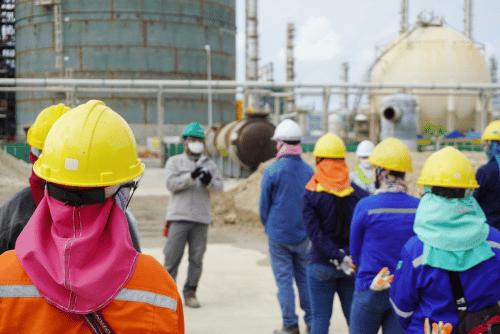A Toolbox Talk, also known as a safety chat or tailgate meeting, is a short, interactive session focused on a specific safety topic in the workplace. These quick sessions are a great way to get workers more involved in health & safety at the workplace. It is also a helpful way of receiving live feedback and concerns from your teams.
How can businesses benefit from health & safety talks?
Some benefits toolbox talks offer are:
- Increased Safety Awareness: They serve as constant reminders of safe practices and potential hazards.
- Improved Communication: These sessions provide a platform for open dialogue between management and employees.
- Proactive Risk Management: Employees become more vigilant and proactive in spotting and reporting hazards.
- Compliance with Regulations: Regular safety talks help ensure that the workplace remains compliant with occupational health and safety regulations.
- Employee Engagement and Morale: Involving employees in safety discussions fosters a sense of ownership and responsibility for workplace safety.
- Reduction in Accidents and Incidents: Consistent reinforcement of safety practices can lead to a decrease in workplace accidents and incidents.
- Skill and Knowledge Enhancement: They learn how to handle equipment safely, respond to emergencies, and perform their tasks with minimal risk.
- Documentation and Record-Keeping: These records can be useful for demonstrating compliance and for evaluating the effectiveness of safety programs.
- Adaptability to Changing Conditions: Toolbox talks can address seasonal hazards, new equipment, or changes in work processes.
- Cost Savings: By preventing accidents and reducing injury-related costs, toolbox talks can lead to significant financial savings for the organization.
The information provided serves as quick refreshers for safety practices and helps reinforce important guidelines. It helps workers become proactive rather than reactive to health and safety issues that arise.
How should a toolbox talk be structured?
1. Choose a Relevant Topic:
- Select a topic that is relevant to your workplace and team that surrounds creating and maintaining a healthy and safe work environment. Consider seasonal factors, specific machinery, or recent incidents.
- Use real stories or examples from news stories to illustrate the importance of safety rules or in-house experiences to the health and safety hazard.
2. Familiarize Yourself with the Content:
- Understand the material you’ll be discussing during the talk.
- Decide on the format you want to use for your presentation.
3. Select an Appropriate Meeting Area:
- Choose a location where everyone can comfortably gather.
- Choose a time when attendance would be high.
- Ensure it’s a quiet space without distractions.
4. Invite the Right Participants:
- Toolbox talks are typically conducted by direct supervisors (foremen or managers). Their credibility lends weight to the discussion.
- If the talk covers specific machinery or specialized knowledge, consider inviting an expert.
- Whenever possible, use visual examples or real equipment to convey information.
- Visual aids make the talk more engaging and memorable.
6. Encourage Participation:
- Ask questions related to the topic to involve participants.
- Ask if there are any other topics the workers would like to discuss in the toolbox talks.
To ensure workers take on accountability, it is recommended to have your employees sign off on a participation form to document what they have been refreshed on.
Need help developing a Toolbox Talk program for your business?
Health and safety requires the participation of everyone in the workplace. Our experts can help you develop a robust health and safety program to keep your workers safe and keep you compliant. call an advisor today at 1 (833) 247-3652.
If you are already a peninsula client and need assistance with developing your toolbox talk, contact our health and safety 24/7 advice line at 1-833-247-3656 ext. 2 or email ohs@peninsula-ca.com.


